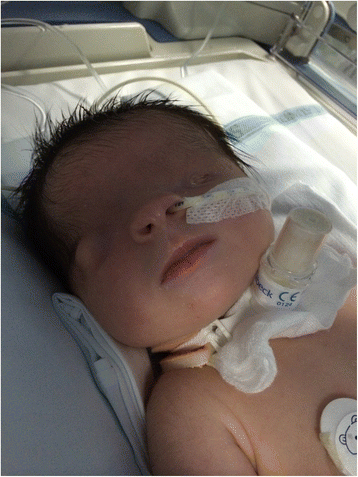Fraser Syndrome 3

A number sign (#) is used with this entry because of evidence that Fraser syndrome-3 (FRASRS3) is caused by homozygous mutation in the GRIP1 gene (604597) on chromosome 12q14.
DescriptionFraser syndrome is an autosomal recessive malformation disorder characterized by cryptophthalmos, syndactyly, and abnormalities of the respiratory and urogenital tract (summary by van Haelst et al., 2008).
For a general phenotypic description and a discussion of genetic heterogeneity of Fraser syndrome, see 219000.
Clinical FeaturesVogel et al. (2012) described 2 unrelated stillborn male fetuses, born to consanguineous parents, with Fraser syndrome. Postmortem investigations in the fist fetus showed bilateral cryptophthalmos, low-set simple ears, micrognathia, and a beaked nose with notch alae nasi. The fingers and toes were short with partial bilateral cutaneous syndactyly. External genitalia were male with a hypoplastic scrotum and malformed hypoplastic penis. The anus was abnormally positioned. The larynx was malformed and atretic, and there was bilateral pulmonary hyperplasia with abnormal lung lobation. The bladder was severely hypoplastic and kidneys were absent. A globe was present in each orbit, but the anterior chamber of the globes appeared abnormal. Prenatal scans of the second fetus showed cryptophthalmos, hyperechogenic lung, and absence of bladder and kidneys. External genitalia were normal. Facial features included bilateral complete cryptophthalmos, abnormal frontal hairline, and broad nose. Vogel et al. (2012) described a third fetus from a pregnancy that was terminated at 30 weeks because prenatal scans showed severe oligohydramnios due to bilateral renal agenesis. Postmortem studies confirmed renal agenesis with bilateral ureter agenesis and hypoplasia of the bladder. The fetus also showed hydrocephaly and dysmorphic features typical of Fraser syndrome.
Molecular GeneticsIn 2 unrelated male fetuses with Fraser syndrome who were known to be negative for mutation in the FRAS1 (607830) and FREM2 (608945) genes, Vogel et al. (2012) identified homozygosity for a splice site mutation in the GRIP1 gene (604597.0001). The unaffected consanguineous parents in both families were heterozygous for the mutation, which was not found in multiple mutation and SNP databases. In addition, the consanguineous parents of a third male fetus with Fraser syndrome were found to be heterozygous for a 4-bp deletion in the GRIP1 gene (604597.0002); no DNA was available from the fetus.
Animal ModelThrough the study of Grip1 -/- mice, Takamiya et al. (2004) found that loss of the Grip1 protein leads to the formation of subepidermal hemorrhagic blisters, renal agenesis, syndactyly or polydactyly, and permanent fusion of eyelids (cryptophthalmos). Similar malformations are characteristic of individuals with Fraser cryptophthalmos-syndactyly syndrome (219000) and animal models of the human disorder, such as mice carrying the 'blebbed' mutation (bl) in the Fras1 gene (607830), which encodes an extracellular matrix protein. Grip1 can visibly interact with Fras1 and is required for the localization of Fras1 to the basal side of cells. In one animal model of Fraser syndrome, the 'eye-blebs' (eb) mouse, Grip1 is disrupted by a deletion of 2 coding exons. From their data, Takamiya et al. (2004) concluded that Grip1 is required for normal cell-matrix interactions during early embryonic development and that inactivation of Grip1 causes Fraser syndrome-like defects in mice. Kiyozumi et al. (2006) showed that eb/eb mice had reduced localization of Fras1, Frem1 (608944), and Frem2 (608945) to epidermal basement membranes.